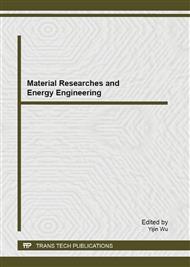p.480
p.487
p.495
p.501
p.507
p.513
p.519
p.524
p.530
Analysis on Even Mass Plutonium Production of Different Loading Materials in FBR Blanket
Abstract:
Spent nuclear fuel (SNF) from nuclear facilities such as from accumulated SNF commercial reactors becomes one of the important issues in term of reducing environmental impact and fuel sustainability as well as nuclear nonproliferation point of view when those SNF materials can be recycled and utilized as new fuel loaded into the reactors. Minor actinides (MA) as one of the important material of spent nuclear fuels can be recycled and transmuted into some useful materials which can be utilized to increase the fuel breeding capability as well as for increasing protected plutonium production from the view point of nuclear nonproliferation issue. Increasing some even mass isotopic plutonium compositions are estimated to increase the level of proliferation resistance level in term of material barrier point of view. The objective of this study is to analyze the proliferation resistance aspect of nuclear fuel based on plutonium production of different loading materials in the FBR blanket. Evaluation is based on some basic parameters of reactor operation analysis, such as reactor operation time which is adjusted to 800 days operation per cycle for 4 fuel batches systems which is refered to the large FBR type of Japan Sodium Fast Reactor (JSFR) design. The results show some nuclear fuels behavior during reactor operation for different loading materials and cycles. Minor actinide (MA) material loading as doping material gives some significant plutonium productions during reactor operation. Some obtained actinide productions have different profiles such as some reducing compositions in americium and neptunium actinide compositions with the time which depends on initial loading material. Some plutonium vector compositions are evaluated from Pu-238 to Pu-242 to estimate the proliferation resistance level as isotopic material barrier of plutonium. Some significant contributions for increasing even mass plutonium as plutonium protected material are shown by Pu-238 from all doping material as well as additional production of Pu-240 and Pu-242 in certain conditions.
Info:
Periodical:
Pages:
507-512
Citation:
Online since:
September 2013
Authors:
Price:
Сopyright:
© 2013 Trans Tech Publications Ltd. All Rights Reserved
Share:
Citation:


